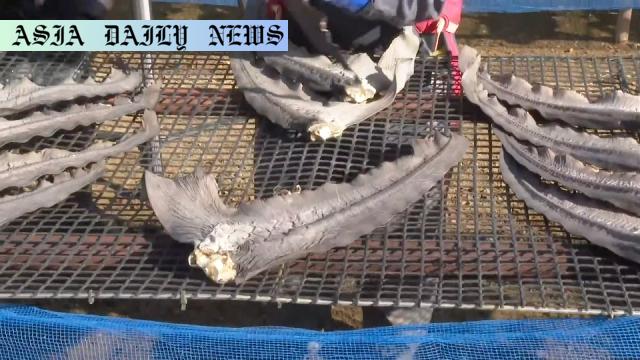Shark fins are sun-dried delicacies prepared over 90 days in Kesennuma, a city in Japan with a 200-year history of shark processing.
Kesennuma in Japan is renowned for its shark fin processing, boasting a 200-year-old tradition.
10,000 fins are being sun-dried under optimal weather, ensuring top-notch quality this season.
The drying process takes up to 90 days, with 30,000 fins expected to ship to restaurants by April’s end.

Introduction to Shark Fin Processing in Kesennuma
Kesennuma, a coastal city in northeastern Japan’s Miyagi Prefecture, stands as a major hub for shark processing. With a remarkable 200-year legacy, the city has refined techniques to prepare shark fins, a high-priced delicacy cherished across the country. As Japan’s leading city in terms of annual shark catches, Kesennuma continues to build on its historic expertise in this industry. Currently, the focus is on the peak drying season, utilizing cold winds and clear skies unique to Japan’s winter climate.
The Art of Shark Fin Drying
The drying process is a meticulous and elaborate operation that requires up to 90 days of consistent effort. At one seafood processing site alone, approximately 10,000 fins are spread across large drying platforms. Under the supervision of workers dedicated to ensuring top-tier quality, each fin is routinely turned over, exposing every surface to the winter sun. This intensive care ensures uniform dehydration and premium quality, giving every fin its distinctive characteristics prized by consumers and chefs alike.
Weather: A Crucial Factor in Quality
According to Toba Etsuo, a senior individual overseeing the drying operations, this season’s stable winter weather bodes well for the fins’ quality. The cold, dry conditions, combined with adequate sunlight, create the optimal environment for dehydrating shark fins. These natural factors, coupled with the laborious work of the employees, guarantee a product that aligns with the high expectations of customers both in Japan and abroad.
Market Demand and Production Goals
This year, the seafood firm at the heart of the tradition plans to produce a substantial 30,000 dried fins by the end of April. Once ready, these fins are destined for high-end restaurants in Tokyo and other culinary hotspots across the nation. The demand for dried shark fins underscores their esteemed status as a luxury product in traditional Japanese cuisine. Despite the physical toll of working in cold temperatures, employees are motivated by their mission to meet customer satisfaction.
Cultural and Culinary Significance
Dried shark fins hold a deep significance in Japanese culture. They are a staple in gourmet dishes, particularly during celebrations and high-profile events. The gelatinous texture and unique flavor they lend to soups and broths have made them a rare delicacy. With Kesennuma’s consistency in upholding quality standards over two centuries, the city has emerged as an essential player in maintaining the authenticity of this highly respected gastronomic tradition.
Preservation of a Legacy
The shark fin drying industry in Kesennuma is more than an economic activity—it is a living legacy passed down through generations. The artisanal process combines natural elements with human expertise, reflecting the harmonious collaboration between tradition and modernity. As global markets shift and evolve, Kesennuma’s unwavering focus on quality ensures the continuity of its rich heritage.
Conclusion
Shark fin production in Kesennuma embodies precision, dedication, and cultural significance. Against the backdrop of cold winter winds and clear skies, workers tirelessly uphold a craft passed down for nearly two centuries. With its commitment to excellence and tradition, the city continues to serve as Japan’s cornerstone of shark fin processing, delivering world-class quality to its clientele.



Commentary
A Tradition of Expertise and Dedication
Kesennuma’s shark fin drying tradition is a remarkable testament to the enduring balance between nature, craftsmanship, and cultural heritage. For over two centuries, this city has been at the forefront of shark fin production in Japan, innovating and refining its techniques to uphold the highest quality standards. The dedication of its workers, who brave cold winds while meticulously turning fins to optimize sunlight exposure, deserves admiration. Their hard work ensures that this delicacy not only meets but exceeds customer expectations.
The Role of Nature in Culinary Excellence
The stable winter weather in Kesennuma is more than a backdrop; it is an active participant in the drying process. The unique combination of cold, dry winds and clear skies is integral to achieving the distinct texture and flavor of dried shark fins. This symbiotic relationship between natural elements and human expertise exemplifies how traditional industries can be supported by their environment to create products of exceptional quality.
Preserving Cultural Heritage
In an era of globalization and rapid industrialization, Kesennuma’s commitment to its 200-year-old tradition is a source of inspiration. While markets and tastes may change, the city’s dedication to cultural and culinary preservation remains steadfast. This speaks volumes about the importance of valuing heritage, not just as a means of economic sustenance but as a significant thread in the fabric of cultural identity. It is this balance between past and present that ensures Kesennuma’s shark fins will remain a prized delicacy for generations to come.